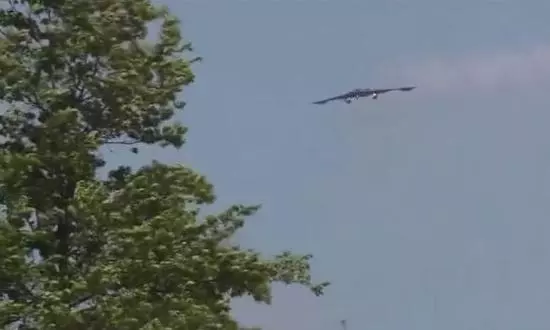
How US used decoys, stealth bombers to strike key Iranian nuclear sites
Dubbed Operation Midnight Hammer, plan was characterised by a precision strike that devastated Iranian nuclear programme, although the full impact of attack is unclear

In an unprecedented attack, US pilots dropped 30,000-pound bombs early on Sunday (June 22) on two key underground uranium enrichment plants (Fordow and Natanz) while firing more than two dozen Tomahawk missiles on the Isfahan nuclear facility in Iran.
The attack, according to American military leaders, is believed to be a knockout blow to a nuclear programme that Israel views as an existential threat.
Dubbed Operation Midnight Hammer, US officials say the plan was characterised by a “precision strike” that “devastated the Iranian nuclear programme,” although the full impact of the attack is still unclear.
Also Read: India debunks claims that US used its airspace for strikes against Iran
Stealth bombers, 18-hour round trip
B-2 stealth bombers reportedly took off from Whiteman Air Force Base at 00:01 EDT, travelling over the Atlantic on an 18-hour round trip that required multiple aerial refuellings. The B-2 stealth bombers were aided by an armada of refuelling tankers and fighter jets — some of which launched their own weapons.
The subsonic jets, which travel just below the speed of sound, flew over the Atlantic Ocean loaded with powerful "bunker buster" bombs capable of penetrating concrete over 18m (60ft) deep.
The mission included 75 precision-guided weapons such as14 GBU-57 “bunker buster” bombs deployed by the seven B-2 Spirit stealth bombers, more than two-dozen Tomahawk cruise missiles launched from a US submarine, 125 aircraft, including the B-2 bombers, fighter jets and refuelling planes.
American sailors bolstered the surprise mission by firing dozens of cruise missiles from a submarine toward at least one other site.
Also Read: What are bunker-buster bombs that US unleashed on Iran's Fordo nuclear facility?
Strike on Isfahan
After 18 hours of furtive flying, the armed B-2 Spirit bombers, each with two crew members, arrived on time and without detection in the Eastern Mediterranean, from where they launched their attack runs.
About an hour before the B-2s entered Iran, US Air Force General Dan Caine said that a US submarine in the region launched more than two dozen Tomahawk cruise missiles against key targets, including a site in Isfahan where uranium is prepared for enrichment.
When the fleet made it to the Middle East, it was joined by support aircraft that helped protect the bombers by sweeping in front of them to look for enemy fighters and surface-to-air missile threats, in what Gen Caine called a "complex, tightly timed manoeuvre".
As the US bombers approached their targets, they watched out for Iranian fighter jets and surface-to-air missiles, but reportedly encountered none.
Also Read: Do the US, Israeli strikes on Iran nuclear sites pose radiation risks?
Moment of impact
At 6:40 pm in Washington (2:10 am in Tehran), the first B-2 bomber dropped its pair of GBU-57 massive ordnance penetrators on the deeply buried Fordo uranium enrichment plant — which is buried below a mountain deep underground and considered to be the epicentre of the country's nuclear programme.
The lead bomber dropped two GBU-57 Massive Ordnance Penetrator weapons - known as MOPs — are able to drop through about 18m (60ft) of concrete or 61m (200ft) of earth before exploding, according to experts.
It is the only bomb in the world that could come close to impacting the depth of tunnels at the Fordo facility. It was the first time these so-called “bunker busters” had ever been used in combat.
Each 30,000-pound bomb is designed to burrow into the ground before detonating a massive warhead. The Fordo site received the bulk of the bombardment, though a couple of the enormous bombs were also dropped on a uranium enrichment site at Natanz.
The US bombs fell for about half an hour, with cruise missiles fired from submarines being the last American weapons to hit their targets, which included a third nuclear site at Isfahan, Caine said.
How US used decoys
In the days leading up to the attack, US President Donald Trump publicly signalled that any decision on whether to strike Iran would be taken within “two weeks,” creating an illusion of delay. This was an effort to mask the impending attack.
One group of B-2 stealth bombers travelled west from Missouri on Saturday (June 21) as decoys, drawing the attention of amateur plane spotters, government officials, and some media as they headed toward a US air base in the Pacific.
All eyes were facing west, towards the Pacific Ocean, following reports that bombers had been sent to the US island territory of Guam. But it was just a ruse - according to the account delivered by the Pentagon — a decoy to distract from the top-secret flights heading straight for Iran over the Atlantic.
At the same time, seven other B-2s carrying two “bunker buster” bombs apiece flew eastward, keeping communications to a minimum so as not to draw any attention.
Also Read: Will Iran's move to block Strait of Hormuz affect oil supplies in India?
Fallout unclear
Remarkably, Iran’s air defence systems and fighter jets reportedly offered no resistance. This can be attributed to nine days of prior Israeli strikes that degraded Iranian radar and command infrastructure.
While the US has declared the operation a success and a potential knockout punch to Iran’s nuclear programme, the full scale of the damage—and its implications for Iran’s nuclear timeline—will take time to assess.
Dr Stacie Pettyjohn of the Center for a New American Security called it “an incredibly sophisticated attack no other country could have executed,” but added that it remains uncertain whether it will result in a lasting setback to Iran’s capabilities.
(With agency inputs)

